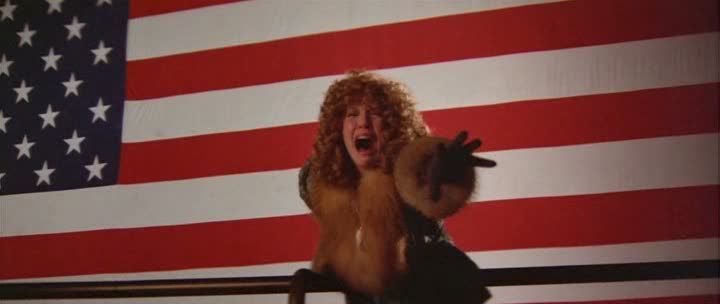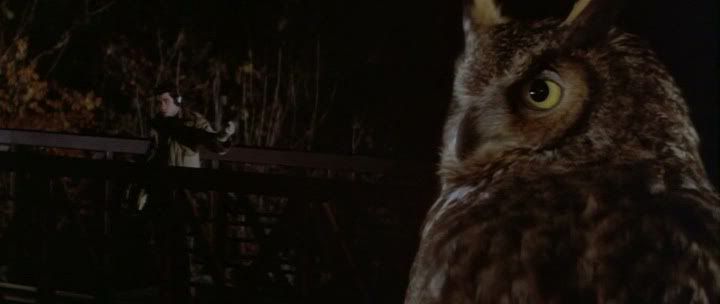
Brian De Palma's Blow Out is the director's idiosyncratic take on Michelangelo Antonioni's Blow-Up, blending it with elements of Francis Ford Coppola's The Conversation and, as usual for De Palma, a host of other cinematic reference points. De Palma's film unmistakeably twists its source material to the director's aesthetic and preoccupations, making it for good or ill its own work, separate from the films it's remaking. Like its predecessors, Blow Out opens with someone inadvertently witnessing a murder, in this case the movie soundman Jack Terry (John Travolta). Terry is out late one night near a lake, recording sounds for a film he's working on, when he sees — and hears, and thus records — a car get a blow out in its tire and crash off the road into the water. Terry jumps into the water and rescues the car's passenger, Sally (Nancy Allen), though the driver is already dead. It's only later that Terry realizes that he has witnessed a murder, that someone lurking in the woods had shot out the tire on that car, causing the crash. And it's only later that he realizes that the man who died in the crash was a governor and a prospective presidential candidate, and that the passenger was not his wife. Terry finds that the politician's friends and allies are now pushing for a cover-up, suppressing the fact that Sally had been in the car when it crashed, and hurrying the investigation through without looking too hard at anything.
Blow Out distinguishes itself from its antecedents by shifting the emphasis away from process and onto the thriller aspects of the plot. In Antonioni's Blow-Up, a photographer takes what he believes, initially, to be some innocuous photos of a couple in a park, but over time, as he examines the photos and becomes obsessed with them, he comes to believe that the images hide, in their details and shadows, the evidence of a murder. In The Conversation, similarly, Coppola focuses on a sound engineer who slowly zeroes in on a fragment of a recorded conversation that, he believes, is suggestive of a murder plot that's set to be enacted soon. In both films, the emphasis is on the slow process by which these men discover what they believe is the decisive evidence; ultimately, the films become psychological and internal, embroiled in nuances of image and sound more than concrete facts.
De Palma dispenses with this angle almost entirely. The mystery in Blow Out is not psychological or internal, and De Palma leaves no doubt about its concreteness by periodically diverting from Terry's perspective to show the actions of Sally and the photographer Manny (Dennis Franz), or the psychopathic Burke (John Lithgow), who committed the initial murder and who continues killing to cover it up. The result is that Blow Out becomes more of a straightforward thriller. Interestingly, where the films that De Palma draws upon placed the audience into the subjectivity of the protagonists' experiences, De Palma consistently allows the audience to be one step ahead of the protagonist. Even during the accident scene, while Terry races to jump into the water after the car, De Palma stages the sequence in a long shot to reveal a shadowy figure in the background, skulking behind Terry and then running away across a bridge at the top of the frame. This will turn out to be Manny, escaping after taking pictures of the accident, and later De Palma will show Sally going to see Manny, revealing that the two of them had been working together to set up the dead politician as a cheater. At other times, De Palma follows the creepy Burke as he plots to cover up the evidence of his crime and eliminate the remaining witnesses.

De Palma might sacrifice the claustrophobic psychological intimacy of Blow-Up and The Conversation, but he gains the propulsive forward momentum of a thriller. The film is taut and tense, centered on Travolta's casually effective performance, which really has the feel of an ordinary guy inadvertently caught up in a conspiracy that stretches far beyond his understanding. In the scenes after the accident, as the police question him, Terry reacts with annoyance and confusion as their questions seem to be steering him away from the facts of what actually happened. Things only get worse from there, and De Palma's decision to incorporate events other than those that directly involve Terry creates the impression that the soundman is caught up in a vast network of shadowy dealings and violence.
This is especially true of the hints one gets of the actions of Burke, a truly chilling character whose role in the film gradually becomes more prominent. At first he's simply a shadowy form, his face unseen, but the more he appears, the creepier he seems. He begins staging a series of sexual murders of women who are the same type as Sally, with the understanding that she'll eventually be slotted in as the final victim in the series. De Palma's staging of the crimes in a bright red light, often filmed from above, sets up the pulse-pounding finale, in which Terry desperately races to get to Sally before Burke kills her. Sally, framed against an American flag, bathed in its red glow, an ironic commentary on the film's political and patriotic backdrops, cries out to Terry, screaming, in one of the film's most bracing and memorable images. Another of the film's most affecting images is a dizzying 360-degree pan around Terry's studio as he realizes that someone — the sinister Burke, though Terry can only pin it on the ubiquitous and mysterious "they" — has erased all of his tapes, including the recordings of the car accident. As Terry scrambles around, putting on one tape after another, filling the room with the empty hum and hiss of blank tapes, the camera turns and turns, tracing a circle around the room to show all these machines playing back the sound of nothingness.
De Palma takes such obvious joy in these kinds of touches that it's obvious that the aesthetics are, in some ways, the real point and subject of this film. Like all of De Palma's films, this is a film that is as much about the texture and style of moviemaking as it is about anything else. There are several sequences where Terry, trying to produce a record of the car accident to prove that there was a shot fired, assembles a movie by marrying a sequence of still frames to his own soundtrack of the incident, creating a movie from these constituent parts. De Palma has taken a lineage of films about sound and images and made a film that celebrates the artistry of the movies, the ability of the cinema to deliver thrills through elements of style. The frantic, fast-paced, over-the-top chase sequence that ends the film makes this point powerfully enough, but then De Palma can't help but offer up one last bitterly ironic twist, as in the film's final moment, when a genuine expression of despair and terror is repurposed, through the magic of moviemaking techniques, as a cheap effect in a shoddy, exploitative B movie. This is perhaps De Palma's cynical joke on himself, on his own process of translating the movies of his forebears into this propulsive thriller. Blow Out may not be as sharp or as deep as the films it channels, but it's a tense, stylish, satisfying thriller in its own right.







0Awesome Comments!